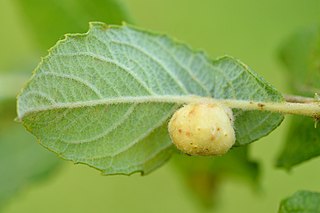Synanthedon flaviventris, the sallow clearwing, is a moth of the family Sesiidae. The larvae form pear-shaped galls on sallows.
Aculus gemmarum is a species of mite which causes galls on the buds of willows. It was first described by Alfred Nalepa in 1892.

Rabdophaga rosariella is a species of gall midge which forms galls on sallows. It was first described by Jean-Jacques Kieffer in 1897.

Rabdophaga salicis is a gall midge which forms galls on sallows. It was first described by Franz von Paula Schrank in 1803.

Aculus craspedobius is a species of mite which causes galls on the leaves of willows. It was first described by Alfred Nalepa in 1925.

Aculus magnirostris is a species of mite which causes galls on the leaves of willows. It was first described by Alfred Nalepa in 1892.

Aculus truncatus is a species of mite which causes galls on the leaves of purple willow. It was first described by Alfred Nalepa in 1892.
Dasineura auritae is a gall midge which forms galls on the leaves of sallows and their hybrids. It was first described by Ewald Heinrich Rübsaamen in 1916.

Iteomyia major is a gall midge which forms galls on willows. It was first described by Jean-Jacques Kieffer in 1889.

Rabdophaga nervorum is a gall midge which forms galls on the leaves of sallows. It is found in Europe and was first described by the French entomologist, Jean-Jacques Kieffer in 1895.

Iteomyia capreae is a gall midge which forms galls on willows. It was first described by Johannes Winnertz in 1853.

Aculus tetanothrix is a species of mite which causes galls on the leaves of willows. It was first described by Alfred Nalepa in 1889.
Aceria iteina is a species of mite which causes galls on the leaves of sallows and their hybrids. It was first described by Alfred Nalepa in 1925.
Euura bridgmanii is a species of sawfly belonging to the family Tenthredinidae. The larvae feed on the leaves of sallows. It was first described by the entomologist Peter Cameron in 1883.

Euura pedunculi is a species of sawfly belonging to the family Tenthredinidae. The larva feed within galls on the leaves of sallows. It was first described by Theodor Hartig in 1837.

Phyllocoptes goniothorax is a species of mite belonging to the genus Phyllocoptes, which causes galls on the leaves of hawthorns. It was first described by Alfred Nalepa in 1889.

Eriophyes laevis is a gall mite which makes small, pimple-like galls on the leaves of alder. The mite was first described by the Austrian zoologist, Alfred Nalepa in 1889 and is found in Europe and North America.
Phyllocoptes malinus, also known as the apple leaf mite, is a species of mite belonging to the genus Phyllocoptes. It causes a gall, which is a swelling on the external tissues, on the leaves of apples. The mite is found in Europe and was first described by the Austrian zoologist Alfred Nalepa in 1892.
Acalitus stenaspis is an eriophyid mite which causes galls on beech. It is found in Europe and was first described by the Austrian zoologist Alfred Nalepa in 1891.

Epitrimerus trilobus is a gall mite in the family Eriophyidae, found in Europe. The mites feed on the leaves of elder (Sambucus species), causing abnormal plant growths known as galls. The mite was described by the Austrian zoologist, Alfred Nalepa in 1891.














